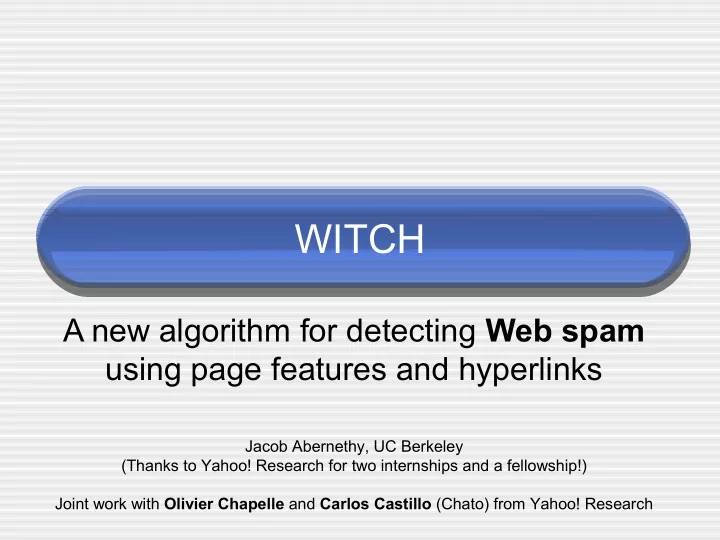

WITCH A new algorithm for detecting Web spam using page features and hyperlinks Jacob Abernethy, UC Berkeley (Thanks to Yahoo! Research for two internships and a fellowship!) Joint work with Olivier Chapelle and Carlos Castillo (Chato) from Yahoo! Research
How to Be a Spammer
Learning to Find Spam • Not a typical learning problem: Web page contents are probably generated adversarially, with the intention of fooling the indexer Given a hyperlink graph, BUT it’s not clear what purpose each link serves: may be natural, may be used for spam, or may simply be there to confuse the indexer
Which of the Blue Hosts are Bad? ? ? ? ? ? ? ? ? ? ? ? ? ? ? ? ? ?
One Key Fact • An extremely useful observation for spam detection: Good hosts almost NEVER link to spam hosts!!
Good does NOT link to Bad! ? ? ? ? ? ? ? ? ? ? ? X ? ? ? ? ? ?
Methods For Web Spam Detection
Graph Based Detection Methods • Graph-based methods try to compute the “spamicity” of a given page using only the hyperlink graph. • Perhaps most well-known is TrustRank, based on the PageRank algorithm.
Content-Based Methods • Train a classifier based on page features: 1. # words in page 2. Fraction of visible words 3. Fraction of anchor text 4. Average word length 5. Compression rate
WITCH Web spam Identification Through Content and Hyperlinks
Key Ingredients • Support Vector Machine (SVM) type framework • Additional slack variable per node • “Semi-directed” graph regularization • Efficient Newton-like optimization
WITCH Framework 1 • Standard SVM : fit your data, but make sure your classifier isn’t too complicated (aka has a large margin)
WITCH Framework 2 • Graph Regularized SVM: fit your data, control complexity, AND make sure your classifier “predicts smoothly along the graph”
WITCH Framework 3 • Graph Regularized SVM with Slack : Same as before, but also learn a spam weight for each node.
Better Graph Regularization: • When A links to B, penalizing the spam score as (S A - S B ) 2 isn’t quite right. This hurts sites that receive links from spam sites. Intuitively, this should be better Undirected Regularization Directed Regularization (S A – S B ) 2 max(0, S A –S B ) 2
NOT TRUE!! • Interestingly, the issue is more complex Undirected Regularization Directed Regularization A mixture of the two types of regularization is better!
Optimal Regularizer Semi-Directed Regularization
Seems Strange, BUT… • Why didn’t simple directed regularization work? • It will fail on certain cases: All out links go to good guys ? All in links come from bad guys
Optimization • Roughly a Newton-method type optimization. • Hard part is computing the Newton Step • Can be accomplished using linear conjugate gradient, ~50 passes over data to get one approximate Hessian. • Requires roughly 10 Newton steps
WITCH Performance Results
Performance Comparison
Web Spam Challenge • Organized By Researchers at Yahoo! Research Barcelona and University Paris 6 • Used a web spam dataset consisting of 10,000 hosts including: 1,000 labelled hosts, roughly 10% spam A Hyperlink graph Content-based features
Web Spam Challenge • We won the 2 nd Track of the Web spam Challenge 2007 (measured by AUC, host-level only) • Our algorithm outperforms the winner of the Track I competition (we were too late to compete).
Performance Results
Final Thoughts
“No Good Bad Links” Assumption? • Perhaps good sites will link to bad sites occasionally: Blog spam “link swapping” Harpers (thanks to reviewer for pointing this out!) • How can we deal with this?
Harpers:
Thank You!! Questions? (and thanks to Alexandra Meliou for the PowerPoint Animations)
Recommend
More recommend